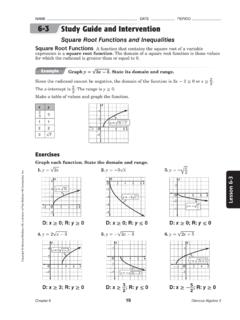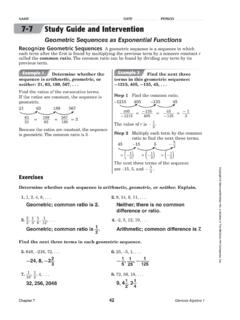Transcription of SELF-STUDY GUIDE FOR IMPLEMENTING HIGH SCHOOL …
1 SELF-STUDY GUIDE FOR IMPLEMENTING HIGH SCHOOL ACADEMIC Department of EducationJohn B. King, Jr., SecretaryInstitute of Education SciencesRuth Curran Neild, Deputy Director for Policy and ResearchDelegated Duties of the DirectorNational Center for Education Evaluation and Regional AssistanceJoy Lesnick, Acting CommissionerAmy Johnson, Action EditorSandra Garcia, Project OfficerREL 2016-218 The National Center for Education Evaluation and Regional Assistance (NCEE) conducts unbiased large-scale evaluations of education programs and practices supported by federal funds; provides research-based technical assistance to educators and policymakers; and supports the synthesis and the widespread dissemination of the results of research and evaluation throughout the United 2016 This publication and ancillary materials were prepared for the Institute of Education Sciences (IES) under Contract ED-IES-12-C-0011 by Regional Educational Laboratory Southeast, administered by Florida State University.
2 The content of the publication and ancillary materials does not necessarily reflect the views or policies of IES or the Department of Education, nor does mention of trade names, commercial products, or organizations imply endorsement by the REL publication and ancillary materials are in the public domain. While permission to reprint or use this publication and ancillary materials is not necessary, it should be cited as:Smith, K. G., Dombek, J. L., Foorman, B. R., Hook, K. S., Lee, L., Cote, , Sanabria, I., & Stafford, T. (2016). SELF-STUDY GUIDE for IMPLEMENTING high SCHOOL academic interventions . (REL 2016 218). Washington, DC: Department of Education, Institute of Education Sciences, National Center for Education Evaluation and Regional Assistance, Regional Educational Laboratory Southeast. Retrieved from publication and ancillary materials are available on the Regional Educational Laboratory website at CreditsPhotographic images used by the Regional Educational Laboratory Southeast at Florida State University on the indicated pages (cover, ii, viii, and x) supplied by Thinkstock in compliance with Florida State University s annual license GUIDE FOR IMPLEMENTING HIGH SCHOOL ACADEMIC INTERVENTIONSD eveloped byKevin G.
3 SmithJennifer L. DombekBarbara R. FoormanKarl S. HookREL SOUTHEAST AT FLORIDA STATE UNIVERSITYAndLaurie LeeAnna Marie CoteIsrael SanabriaTammy StaffordREL SOUTHEAST IMPROVING LITERACY RESEARCH ALLIANCE MEMBERSA ugust 2016iiiSelfflstudy GUIDE for IMPLEMENTING high SCHOOL academic interventionsIntroductionWhile academic interventions can be implemented in any grade, focusing on interventions in high SCHOOL is critical because it is often a student s last chance to become ready for the academic demands of postsecondary education and across the country are IMPLEMENTING large scale initiatives focused on delivering academic interventions in the high SCHOOL grades. This self study GUIDE provides a template for data collection and guiding questions for discussion that may improve the implementation of high SCHOOL academic interventions and increase the number of students meeting college and career readiness GUIDE is intended to help district and SCHOOL based practitioners conduct self studies for planning and IMPLEMENTING high SCHOOL academic interventions .
4 Self study is a process of using a GUIDE with predetermined focus areas and questions to collect, share, and discuss data with stakeholders. The process can include teachers, instructional coaches, guidance counselors, SCHOOL based administrators, district administrators, and chief academic officers knowledgeable in high SCHOOL academic interventions . It may help educators ensure strong implementation of interventions and document current practices in IMPLEMENTING a specific academic practice, multitiered system of support, or response to intervention policy. An ideal time for conducting a self study of implementation of academic interventions is the beginning or end of the SCHOOL year so that prior-year implementation can be considered and planning can occur for implementation for the next SCHOOL , districts, and schools that are IMPLEMENTING or planning to implement high SCHOOL academic interventions may find this GUIDE helpful as they consider which types of evidence to collect and which components of high SCHOOL academic interventions are important for evaluating and meeting the need for academic interventionsWhile many districts and schools recognize the need for high SCHOOL academic interventions , successful implementation is often a challenge.
5 The Self study GUIDE for IMPLEMENTING High SCHOOL Academic interventions will be most effective if each SCHOOL s current situation and needs are considered. Prior to completing this GUIDE , a team of educators at the SCHOOL might consider current academic intervention needs and practices. This team may consist of teachers, others who deliver academic interventions , and relevant SCHOOL based administrators and staff (for example, lead teachers, instructional coaches, response to intervention coordinators, and guidance counselors). As the team completes the GUIDE , the following overarching questions may be beneficial in determining how interventions are being carried out and what changes may be needed: What is the need for academic interventions at my SCHOOL ? How are my students performing and how many need to be served?IntroductionivSelfflstudy GUIDE for IMPLEMENTING high SCHOOL academic interventions In what components of academics (literacy and math) are my students struggling?
6 How will we determine which students are served through academic interventions ? Will additional adults or cross age tutors enter the classroom to assist the teacher in differentiating instruction in small groups? Will students be pulled out of their classroom to receive intervention? How many minutes each day, days per week, and weeks per year will students receive intervention? What challenges will be encountered when delivering high quality academic interventions and how can these challenges be overcome?Purpose and use of the SELF-STUDY guideThe purpose of the Self study GUIDE for IMPLEMENTING High SCHOOL Academic interventions is to help districts and schools: Gather baseline information to use in developing an implementation plan for academic interventions . Prioritize their needs as they develop their implementation plan for academic interventions . Gather progress monitoring information for continuous improvement of academic interventions .
7 Evaluate the implementation of academic GUIDE was designed to promote reflection about current strengths and challenges in planning or implementation, spark conversations among staff, and identify areas for improvement. Based on pilot testing, the use of this GUIDE for SCHOOL level self study will take three to five hours. Time estimates are provided in the process steps outlined in box 1. It may be helpful to elicit input from participating teachers and others who deliver academic interventions , in addition to instructional coaches and SCHOOL based self study GUIDE works best if a dedicated facilitator leads the process for members of the self study GUIDE team. The facilitator should be knowledgeable in best academic intervention practices from research as well as in intervention policies, procedures, and implementation and should review the GUIDE in detail before the self study begins. This review will take approximately two hours.
8 The facilitator should also collect relevant data and possible sources of evidence before convening a meeting. The facilitator should be a careful listener and able to lead and structure discussions around collected evidence and decision making GUIDE for IMPLEMENTING high SCHOOL academic interventionsComponents of the guideThe Self study GUIDE for IMPLEMENTING High SCHOOL Academic interventions consists of the Scoring GUIDE , Implementation Consensus Rating Form, and Planning Next Steps GuideThe Scoring GUIDE includes guiding questions and potential sources of evidence to support districts and schools in reviewing district and SCHOOL based planning and implementation of interventions . The Scoring GUIDE is tied to SCHOOL actions and uses a four point scale to assess the current status of implementation. The content of the Scoring GUIDE is based on eight areas: student selection, assessment selection and data use, content and instruction, instructional time, interventionist or teacher selection, professional development and ongoing support, communication, and intervention or classroom environment.
9 An annotated bibliography of the research supporting each scoring GUIDE area is provided in appendix A. Box 1 explains how to use the Scoring Consensus Rating FormAfter the Scoring GUIDE is completed, the facilitator guides the self study team through a consensus rating process. The team uses the Implementation Consensus Rating Form to reach agreement on the current status of implementation in the SCHOOL and on planning the next steps. The most important part of this process for states, districts, and schools is the discussion that goes into consensus rating. The scores on the Implementation Consensus Rating Form should reflect this facilitated discussion. Box 1 lists the steps for completing the Implementation Consensus Rating Next Steps FormThe Planning Next Steps Form is used to prioritize the areas based on the strength of evidence and importance for success as described in the literature. The self study team should review the consensus ratings showing a need to develop or improve, identify two or three top priorities from the eight areas for action planning, record the priority areas, complete a detailed plan for next steps and activities, and note any potential challenges.
10 Box 1 explains how to use the Planning Next Steps GUIDE for IMPLEMENTING high SCHOOL academic interventionsBox 1. Steps to complete the Scoring GUIDE , Implementation Consensus Rating Form, and Planning Next Steps Form Recruit five to seven members who will make up the self study team, and convene a meeting to complete the self study process. Select a dedicated and knowledgeable facilitator. Then recruit teachers, others who deliver academic interventions , and relevant SCHOOL based administrators (instructional coaches, response to intervention coordinators, lead teachers, and guidance counselors) knowledgeable in academic intervention policies and implementation to complete the team. Present an overview of the self study process to all team members, including a review of relevant data and possible sources of evidence collected by the facilitator. [Activity length: 30 minutes] Have each team member individually review the content of the Scoring GUIDE for each specific area that will be rated (for example, Student Selection, Assessment Selection and Data Use, Content and Instruction) and appendix A (Support for Scoring GUIDE areas).



















